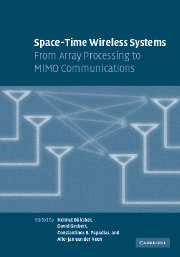Book contents
- Frontmatter
- Contents
- List of contributors
- Acknowledgments
- Introduction
- Part I Multiantenna basics
- Part II Space-time modulation and coding
- Part III Receiver algorithms and parameter estimation
- Part IV System-level issues of multiantenna systems
- Part V Implementations, measurements, prototypes, and standards
- 23 What we can learn from multiantenna measurements
- 24 Experiments in space-time modulation and demodulation
- 25 Multiple antenna techniques in 3G wireless systems
- 26 MIMO wireless local area networks
- 27 VLSI implementation of MIMO detection
- Index
24 - Experiments in space-time modulation and demodulation
Published online by Cambridge University Press: 25 February 2010
- Frontmatter
- Contents
- List of contributors
- Acknowledgments
- Introduction
- Part I Multiantenna basics
- Part II Space-time modulation and coding
- Part III Receiver algorithms and parameter estimation
- Part IV System-level issues of multiantenna systems
- Part V Implementations, measurements, prototypes, and standards
- 23 What we can learn from multiantenna measurements
- 24 Experiments in space-time modulation and demodulation
- 25 Multiple antenna techniques in 3G wireless systems
- 26 MIMO wireless local area networks
- 27 VLSI implementation of MIMO detection
- Index
Summary
Introduction
Over the past decade, there has been a great deal of research to improve the performance of wireless communications in fading environments by exploiting transmitter and/or receiver diversity. The pioneering work by Teletar (1995), Foschini and Gans (1998) showed that multiple antennas in a wireless communication system can greatly improve performance and spectral efficiency. For Lt transmit antennas and Lr receive antennas in Rayleigh fading, it was shown that, with spatial independence, there are essentially LtLr levels of diversity available and there are min(Lt, Lr) independent parallel channels that can be established. These information-theoretic studies spawned two lines of work; one where the number of independent channels is large (Foschini, 1996) and one where the number of independent channels is small (Tarokh et al., 1998; Guey et al., 1996). With eight years of intense engineering research and development effort after these insights, Multiple antenna radio (MAR) techniques are starting to make a significant impact on how wireless services are provided. Examples include the nascent IEEE 802.11n standard and 4G mobile telecommunication systems. Progress in this area is such that researchers are calling the area mature.
The open problems in MAR communications relate to situations where more sophisticated and detailed aspects of communication systems need to be modeled and understood. For example, performance is not easily understood in channel models that are not well modeled as Gaussian/Rayleigh, or where the scattering is not rich or isotropic, or where system/channel parameters are time-varying, or how hardware nonidealities impact system performance.
- Type
- Chapter
- Information
- Space-Time Wireless SystemsFrom Array Processing to MIMO Communications, pp. 487 - 508Publisher: Cambridge University PressPrint publication year: 2006
- 1
- Cited by



